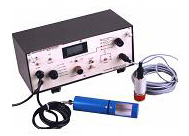Field Dynamic Balancing Equipments

Specification :
» Displacement Mode : 0-2000 microns pk-pk } RPM
» Velocity Mode : 0-200 mm/sec pk } 20,000 RPM
Band Pass Mode :
» Frequency Range : 200 RPM TO 20,000 RPM
» Relative Amplitude : 30 dB ATTENUATOR IN 2 STEPS
» Active Filter : Selectivity gain 60 Db.
» Correction Mode : Add Mass or Remove Mass. (band width 3 Db nominal)
» Rpm Mode : 0 - 20,000 RPM IN TWO RANGES
» Temperature Range : -10oC to + 55oC
» Power : 220 Volts AC +/- 10%, 50 Hz
For conventional Balancing, the rotating part has to be dismantled from the assembly, taken to the standard Balancing Machine, mounted on cradle, coupled to and driven with a suitable prime mover.
This portable equipment ( Field Dynamic Balancing Equipment ) would enable the operator to carry out balancing without dismantling the machine, by rotating the component in its own frame; thereby saving expensive labour and costly down time. Furthermore, it gives better results than the conventional balancing, as it can detect and correct the residual unbalance due to total assembly, thus accounting for all the fitting tolerances. Balancing at operating speed is another advantage.
This equipment also incorporates a Vibration Meter apart from field Balancing set, which facilitates the absolute measurement of vibration in terms of Displacement in microns or Velocity in mm / sec.


